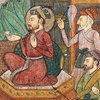MASK, förgylld och bemålad kopparlegering. Nepal, troligen 16/1700-tal.
Troligen föreställande Bhairava, förgylld och bemålad. Mått 23x19 cm.
Slitage.
Proveniens
The Bengt and Lilavati Häger Collection of Indian Collection of Indian, Southeast Asian, Chinese and Japanese Art.
Lilavati and Professor Bengt Häger’s art collection was culturally significant and vast. It is clear that it was founded on the couples cross cultural experiences. Lilavati was a leading exponent of Indian dance and Bengt one of the most important European Impresarios of his day.
Multitalented and highly regarded Bengt Häger (1916-2011) worked inexhaustibly throughout his life to promote dance as an independent art form and field of research. He founded and managed the Swedish Dance Museum, the University Collage of Dance and Circus in Stockholm. He worked actively to bring international guest performances from world leading dance companies. Organized international torus for Swedish dance companies such as the Cullberg Ballet, which he managed 1967-1987. He was the first to bring Peking Opera out of China after the revolution and was a great friend of the renowned Peking Opera singer Mai Lanfang.
For many years Mr Häger was the closest friend and collaborator of the famous Art Collector Rolf the Maré (1888-1964), founder of Ballet Suedois in Paris. Bengt was also involved with UNESCO and founded the Centre International de Dance.
Lilavati Devi (1925-2002). First came to Sweden as a principal performer of the dance company set up by Ram Gopal (1912-2003), the Nijinsky of India. Bengt and Lilavati married in 1954. She became an important ambassador of Indian Dance in Scandinavia. They couple came to inhabit a circle that included some of the major international dancers, performers and choreographers of the last Century.
Övrig information
The mask probably depicts a fierce form of the Hindu god Shiva known as Bhairava, or “The Terrifying One.” Here he exhibits a broad face with bulging eyes and gaping mouth, a five-pointed crown with elements that are peaceful (jewels) and wrathful (skulls and snakes), hair standing on end, and fiery facial hair, all typical features of fierce images of Hindu and Buddhist deities. His identity as a form of Shiva can be deduced from the small snake in his hair above the central point of his crown and the crescent at the side of its tail, both symbols associated with Shiva. In addition the small head at the center of the crown is that of Shiva.
This mask was used to dispense beer during Hindu festival processions in Nepal. A tube would be used to connect the mouth of the mask to a hidden reservoir of alcohol—the hole for the tube is still evident—allowing the drink to be poured into the mouths of devotees. Such rituals were meant to confer benefits throughout the year.






































